Animals and the Environment: Form and Function
1/56
Earn XP
Description and Tags
Flashcards covering key vocabulary and concepts related to the form and function of animals, focusing on their biological structure, physiology, and environmental interactions.
Name | Mastery | Learn | Test | Matching | Spaced |
|---|
No study sessions yet.
57 Terms
Anatomy
The biological form of an organism.
Physiology
The biological functions an organism performs.
Homeostasis
The maintenance of a stable internal environment.
Countercurrent exchange
A method of exchanging heat between blood in arteries and veins to maintain body temperature.
Osmoregulation
Balancing the uptake and loss of water and solutes.
Gas exchange
The process of exchanging oxygen and carbon dioxide between an animal and its environment.
Nitrogenous wastes
Waste products from metabolism that contain nitrogen, reflecting an animal's physiology and habitat.
Asexual reproduction
A mode of reproduction that does not involve the fusion of gametes and often results in rapid population growth.
Sexual reproduction
A mode of reproduction that involves the combination of genetic material from two parents.
Circulatory systems
Systems that link exchange surfaces with cells throughout the body to facilitate the movement of materials.
Adaptive immunity
A type of immunity that provides pathogen-specific recognition.
Innate immunity
A type of immunity that relies on traits common to groups of pathogens.
Ecosystem
A community of living organisms interacting with their environment.
Biome
A major ecological community defined by distinctive plant and animal groups and the climate in which they exist.
What is climate?
Climate refers to the long-term patterns and averages of weather conditions in a specific area over an extended period of time.
What are the types of osmoregulation?
There are two main types of osmoregulation: 1) Osmoconformers, which maintain internal conditions equal to their surroundings, and 2) Osmoregulators, which actively control their internal environment independent of their surroundings.
What are the major dietary needs for animals?
1) Carbohydrates: Provide energy and are essential for cellular functions. 2) Proteins: Necessary for growth, repair, and the production of enzymes and hormones. 3) Fats: Supply concentrated energy and are crucial for cell membrane structure. 4) Vitamins: Required in small amounts for various biochemical functions. 5) Minerals: Important for bone health, nerve function, and muscle contraction. 6) Water: Essential for hydration, nutrient transport, and biochemical reactions.

look at image for question(from past exam)
Physiology so to do with function: Heat exchange.

look at image for question(from past exam)
D.
What are five common fundamental challenges faced by all animals?
1) Nutrient acquisition: Animals need to find and digest food. 2) Oxygen uptake: Animals require oxygen for metabolic processes. 3) Waste removal: It is essential to excrete metabolic waste to maintain bodily functions. 4) Adaptation to the environment: Animals must adapt to various environmental changes. 5) Reproductive methods: Animals must reproduce to ensure the survival of their species.
How does an animal's size, shape, and complexity influence its need for specialized structures for material exchange?
1) Small organisms like amoebas have a high surface area-to-volume ratio, allowing direct absorption of nutrients across their cell membranes.
2)aquatic animals have gills, which are folded structures that increase surface area for oxygen exchange in water.
3) Larger animals, such as mammals, possess complex lungs with branching airways and alveoli to facilitate gas exchange efficiently, catering to their higher metabolic demands.
What does the exchange of materials across animal cell membranes involve?
Materials such as nutrients, waste products, and gases must be exchanged across the cell membranes of animal cells.
The rate of exchange is proportional to a cell’s surface area, while the amount of exchange material is proportional to a cell’s volume.
What distinguishes innate immunity from adaptive immunity?
Innate immunity is the immediate and non-specific defense mechanism that animals are born with, including physical barriers and immune cells. Adaptive immunity, on the other hand, develops over time and is specific to particular pathogens, involving the creation of memory cells and antibodies tailored to those pathogens.
Which taxa of animals primarily exhibit innate immunity?
Invertebrates predominantly display innate immunity, relying on physical barriers and immune cells that non-specifically respond to pathogens. This includes organisms such as arthropods, annelids, and mollusks.
Which taxa of animals has the capability to possess adaptive immunity?
Vertebrates are characterized by their adaptive immunity, which includes the production of specific antibodies and memory cells that provide long-term protection against previously encountered pathogens. This encompasses mammals, birds, reptiles, amphibians, and bony fish.
What types of immune responses do invertebrates utilize?
Invertebrates utilize innate immune responses, featuring physical barriers and various immune cells that act against pathogens without specificity.
What types of immune responses do vertebrates utilize?
Vertebrates utilize both innate and adaptive immune responses, with the innate component providing immediate defense and the adaptive component developing specific, long-lasting immunity to specific pathogens.

look at image for question(from past exam)
The individual will secrete large amounts of water in the form of dilute urine.
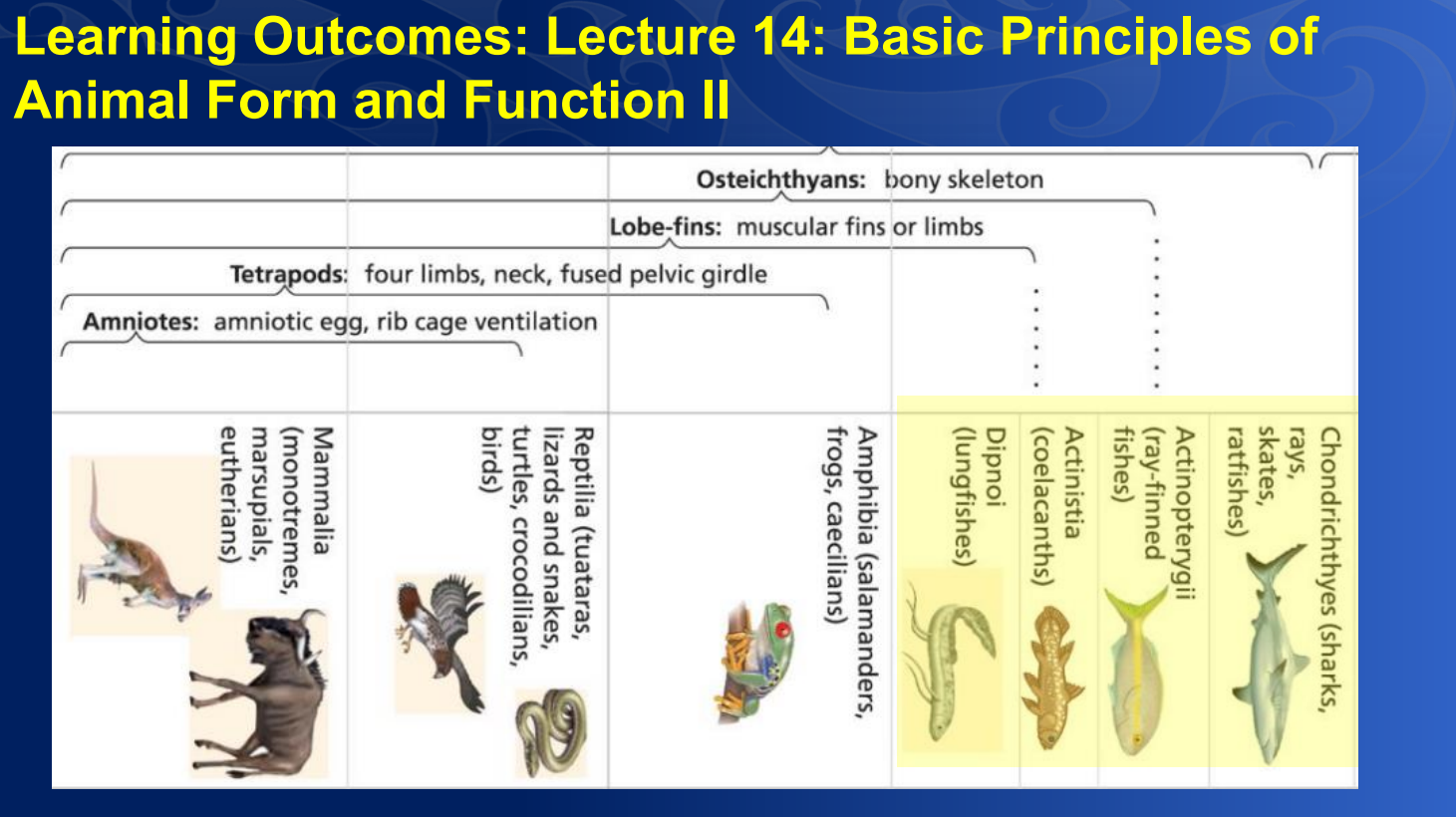
What is osmoregulation, and how do marine bony fish and freshwater bony fish respond to osmotic challenges?
Osmoregulation is the biological process by which organisms maintain water and solute balance within their bodies, ensuring homeostasis. Marine bony fish are osmoregulatory; they actively manage salt excretion through specialized cells and retain water to counter dehydration from their hypertonic environment. In contrast, freshwater fish face the osmotic challenge of excess water intake, leading them to excrete dilute urine and retain ions through their gills and kidneys, thus preventing excess water retention and maintaining osmotic balance.
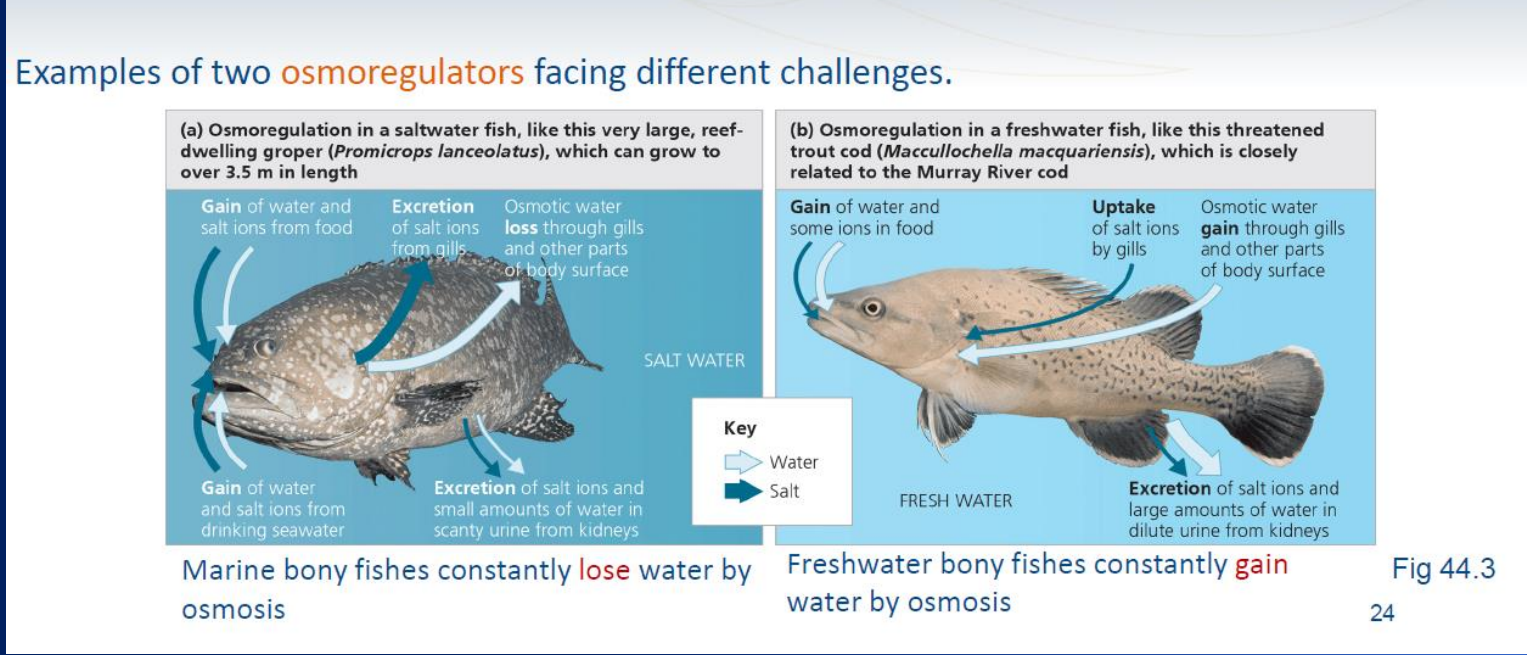
What is osmoregulation?
Osmoregulation is the process by which organisms control the balance of water and salts in their bodies to maintain homeostasis, adjusting to their external environments.
What does the term 'osmoregulatory' refer to?
'Osmoregulatory' describes the mechanisms and processes that organisms, particularly those that actively manage their internal water and electrolyte balance, utilize to maintain osmotic balance.
What is an osmoconformer?
An osmoconformer is an organism that has an internal osmotic environment that is isotonic to the surrounding water, allowing it to match the external osmotic pressure without active regulation.
How do marine bony fish manage osmotic challenges?
Marine bony fish manage osmotic challenges by actively excreting excess salts through specialized cells in their gills, while consuming seawater to maintain hydration.
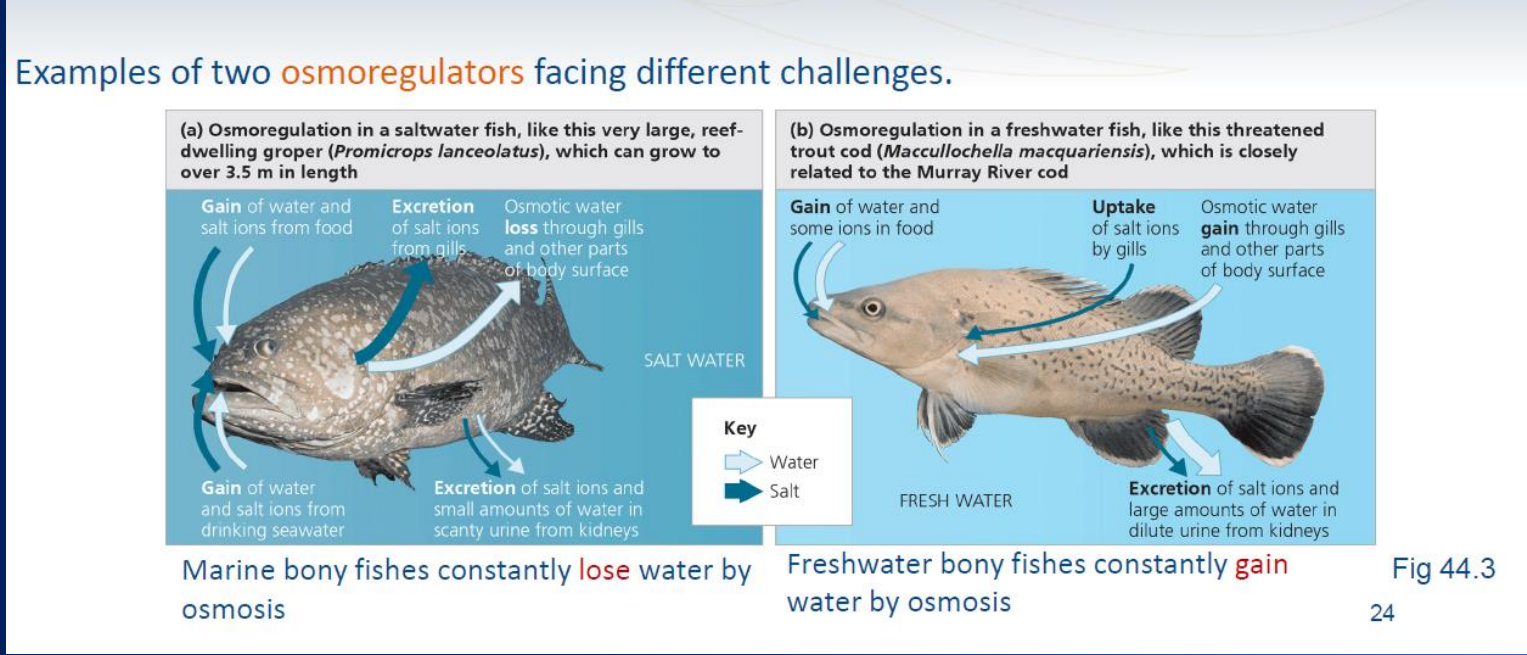
How do freshwater bony fish cope with osmotic challenges?
Freshwater fish cope with osmotic challenges by absorbing water through their skin and gills, producing large volumes of dilute urine to excrete excess water while actively reabsorbing salts.

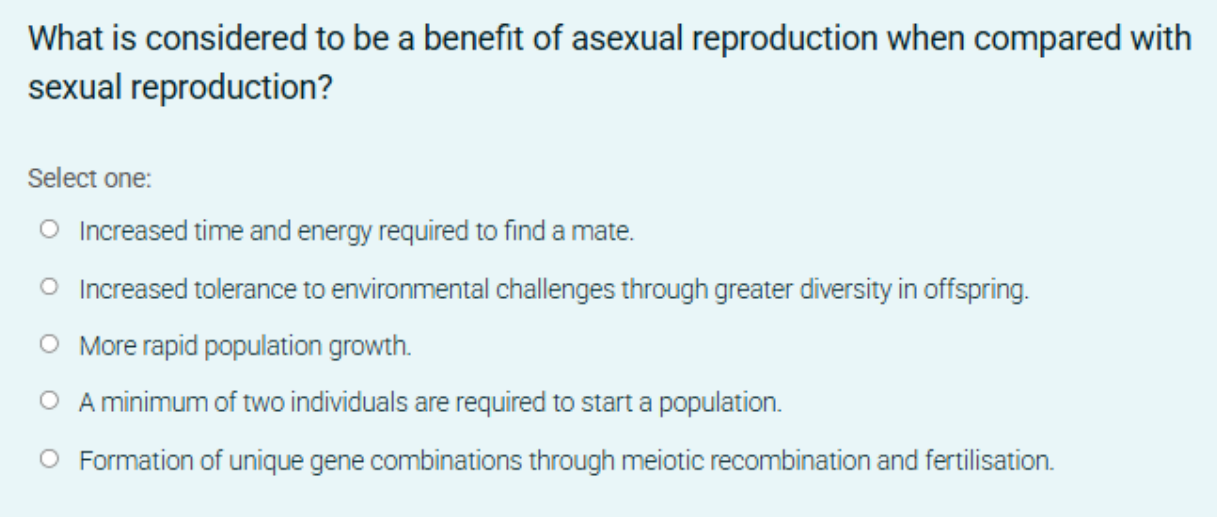
look at image for question(from past exam)
More rapid population growth
What are the main benefits of asexual reproduction?
Asexual reproduction allows for rapid population increases, requires less energy since it does not involve finding a mate, and enables successful organisms to reproduce quickly in stable environments.
What are the main costs of asexual reproduction?
The primary cost of asexual reproduction is the lack of genetic diversity, which can make populations vulnerable to diseases and environmental changes.
What are the main benefits of sexual reproduction?
Sexual reproduction increases genetic variation in offspring, which enhances adaptability and survival in changing environments and can lead to evolutionary advantages.
What are the main costs of sexual reproduction?
The costs include the need to find a mate, which can consume time and energy, as well as generally producing fewer offspring compared to asexual reproduction.
What is the ‘twofold’ cost of sexual reproduction?
The ‘twofold’ cost of sexual reproduction refers to the inefficiency of the slower population growth rate compared to asexual reproduction. It highlights that only females can produce offspring, reducing the reproductive output of the population.
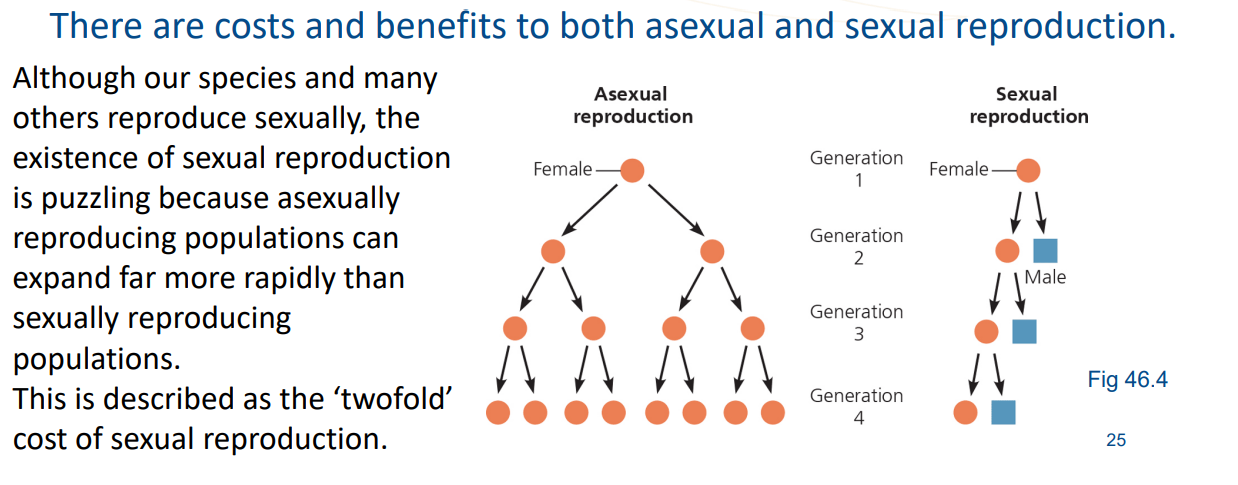
True or False: Some species can utilize both asexual and sexual reproduction.
True. Some species are capable of both asexual and sexual reproduction, allowing them to exploit the benefits of each reproductive strategy (efficiency and diversity) depending on environmental conditions. e.g. some parasites use different strategies in different stages of there lifestyle.
If the direction of Earth’s rotation reversed, what would the most predictable effect be?
a) A big change in the length of the year
b) A loss of seasonal variation at high latitudes
c) The elimination of ocean currents
d) Winds blowing from west to east along the equator
Rotation direction would reverse the existing direction of these winds:
d) Winds blowing from west to east along the equator.
What is the relationship between latitude and climate?
Climate varies by latitude due to differences in solar radiation; lower latitudes (near the equator) receive direct sunlight year-round, resulting in warmer temperatures, while higher latitudes experience cooler temperatures and more extreme seasonal changes.
How do seasonal variations impact ecosystems at high latitudes?
High latitudes face dramatic seasonal variations, leading to ecosystems that must adapt to short growing seasons, prolonged winters, and a unique set of flora and fauna adapted to these conditions.
What role do ocean currents play in seasonal climate changes?
Ocean currents can exacerbate or moderate seasonal climate changes by transferring heat from the equator to poles, thus influencing weather patterns and temperatures in coastal and nearby land areas.
How do winds contribute to climate variances across latitudes?
Winds influence climate by distributing heat and moisture around the planet; they can create regional climate differences, such as arid conditions in some areas while bringing moisture to others.
How does variation in solar radiation affect global climates?
Variation in solar radiation affects global climates by influencing temperature, precipitation patterns, and seasonal changes; areas receiving more direct sunlight tend to be warmer and wetter, while regions receiving less sunlight experience cooler, drier conditions.
What is the Biosphere?
The biosphere refers to the entire realm of living organisms on Earth, encompassing all ecosystems where life occurs. It includes the interactions of these organisms with one another and with their physical environment, such as land, water, and the atmosphere.
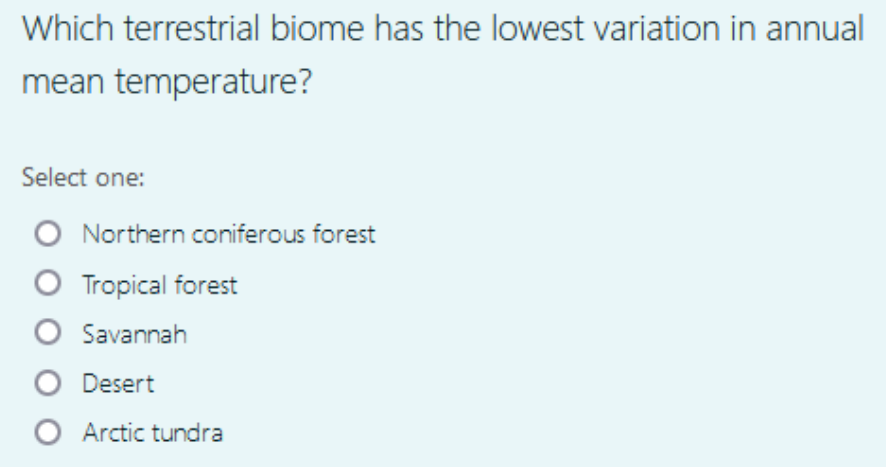
look at image for question(from past exam)
Tropical Forest
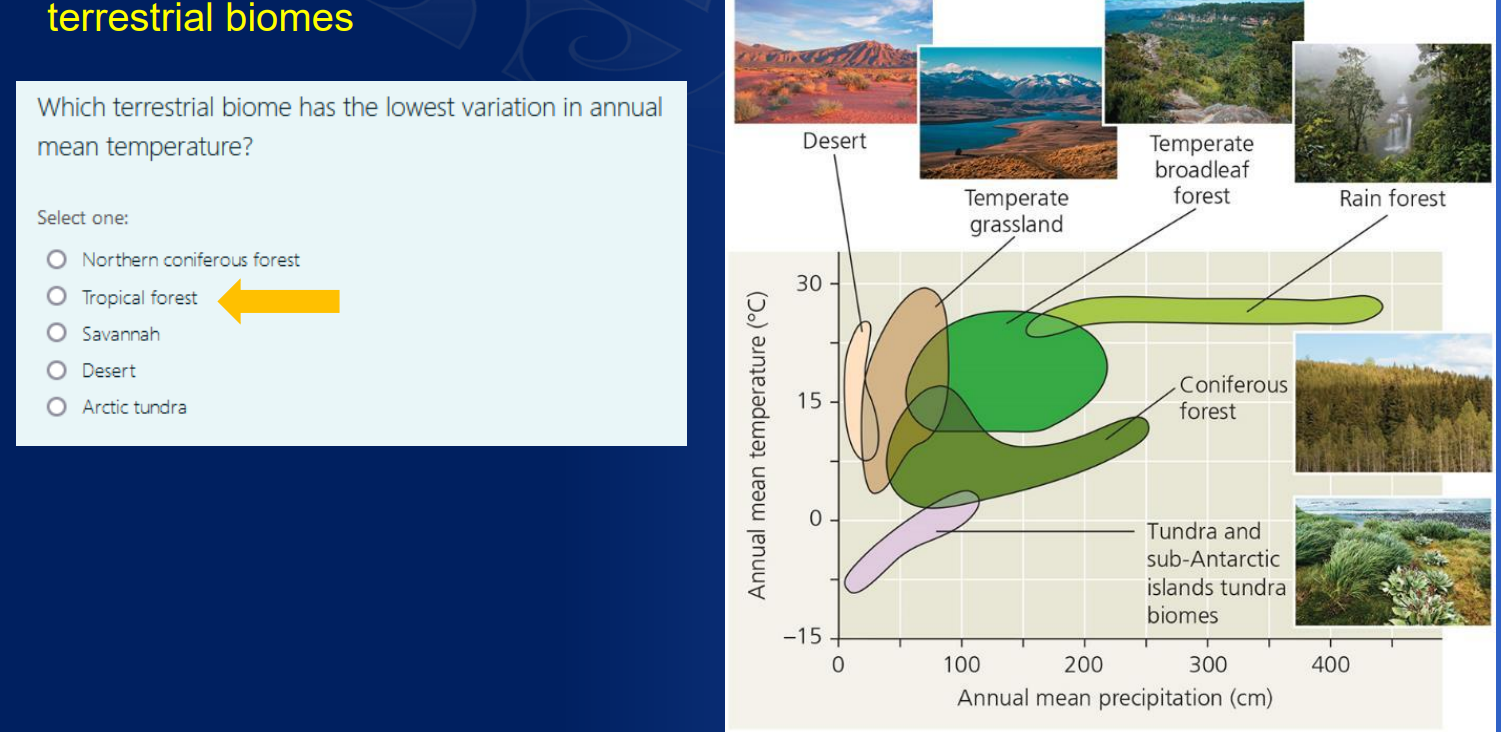
What are the main types of terrestrial biomes and there characteristics?
Tropical Forests: Characterized by high rainfall, warm temperatures, and a rich diversity of plant and animal life.
Deserts: Defined by low precipitation, extreme temperature variations, and specialized flora and fauna adapted to arid conditions.
Temperate Forests: Known for moderate climates, distinct seasonal changes, and a mix of deciduous and coniferous trees.
Grasslands: Dominated by grasses, with few trees; they support large herbivores and are often subject to fires.
Taiga (Boreal Forests): Found in cold regions, characterized by coniferous trees, long winters, and short summers.
Tundra: A cold biome with permafrost, low temperatures, and limited vegetation, mainly mosses and lichens.
Which terrestrial biome has the lowest mean temperature?
A. Desert
B. Tundra
C. Grassland
D. Tropical Rainforest
Answer: B. Tundra
Which terrestrial biome exhibits the greatest variation in temperature out of the following?
A. Temperate Forest
B. Savanna
C. Desert
D. Boreal Forest
E. Temperate Grassland
Answer: E Temperate Grassland
What is the primary characteristic of the Tundra biome?
A. Very low temperatures
B. High humidity
C. Frequent rainfall
D. Warm temperatures
A. Very low temperatures
What defines the Desert biome in terms of precipitation?
A. Consistent heavy rainfall
B. Seasonal flooding
C. Very low precipitation levels
D. Moderate rainfall throughout the year
C. Very low precipitation levels
Which Terrestrial biome typically features grasses and few trees?
A. Desert
B. Tundra
C. Grassland
D. Tropical Rainforest
C. Grassland
What is a characteristic of the Tropical Rainforest biome?
A. High biodiversity and dense vegetation
B. Cold temperatures year-round
C. Frequent snow cover
D. Low humidity levels
A. High biodiversity and dense vegetation